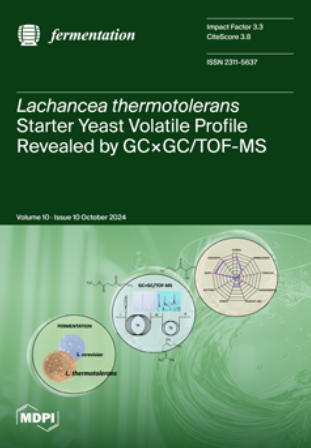Solid-State Fermentation as a Sustainable Tool for Extracting Phenolic Compounds from Cascalote Pods
IF 3.3
3区 农林科学
Q2 BIOTECHNOLOGY & APPLIED MICROBIOLOGY
引用次数: 0
Abstract
Cascalote pods are an important source of phenolic compounds, mainly recovered using solvent extraction methods. To find a sustainable alternative to these methods, this study aimed to evaluate solid-state fermentation (SSF) in order to enhance the extractability of total phenolic compounds (TPC) with antioxidant activity (AA) from cascalote pods. Aspergillus niger GH1 was selected based on the amount of TPC released and AA measured (ABTS, DPPH, FRAP) in a short period of time. Moreover, moisture, temperature, inoculum size, and mineral composition were evaluated. The largest amount of TPC released was 124.17 mg/gdw (g of dry weight) after 12 h of culture, which significantly correlated with the AA (Pearson’s R = 0.94). Moisture and KH2PO4 concentration were the main influencing factors of TPC release. Treatment 6 (1 × 107 spores/gdw, 30 °C, 60% moisture, mineral composition (g/L): KH2PO4, 1.52; NaNO3, 7.65; and MgSO4, 1.52) was selected due to the highest values of both TPC and AA. SSF-assisted extraction allowed for an increase of 118% and 93% in TPC and AA values, respectively. Corilagin, lagerstannin, geraniin, and ellagic acid were the main phenolic compounds identified by RP-HPLC-ESI-MS in the cascalote extracts. The results obtained demonstrate the feasibility of SSF-assisted extraction as a biotechnological alternative for the recovery of important bioactive molecules from this underutilized material.固态发酵作为一种可持续的从Cascalote荚中提取酚类化合物的工具
Cascalote荚是酚类化合物的重要来源,主要通过溶剂萃取方法回收。为了找到这些方法的可持续替代方案,本研究旨在评估固态发酵(SSF),以提高具有抗氧化活性(AA)的总酚类化合物(TPC)的可提取性。黑曲霉GH1是基于短时间内释放的TPC和测量的AA(ABTS、DPPH、FRAP)的量来选择的。此外,还对水分、温度、接种物大小和矿物成分进行了评估。培养12h后,TPC的最大释放量为124.17mg/gdw(g干重),与AA显著相关(Pearson’s R=0.94)。水分和KH2PO4浓度是影响TPC释放的主要因素。处理6(1×107孢子/gdw,30°C,60%湿度,矿物成分(g/L):KH2PO4,1.52;NaNO3,7.65;和MgSO4,1.52)。SSF辅助提取使TPC和AA值分别增加118%和93%。RP-HPLC-ESI-MS法鉴定了卡司卡卢特提取物中的主要酚类化合物为珊瑚苷、拉格斯坦宁、香叶苷和鞣花酸。所获得的结果证明了SSF辅助提取作为从这种未充分利用的材料中回收重要生物活性分子的生物技术替代方案的可行性。
本文章由计算机程序翻译,如有差异,请以英文原文为准。
求助全文
约1分钟内获得全文
求助全文
来源期刊

Fermentation-Basel
BIOTECHNOLOGY & APPLIED MICROBIOLOGY-
CiteScore
3.80
自引率
18.90%
发文量
594
审稿时长
7 weeks
期刊介绍:
Fermentation-Basel is an international open access journal published by MDPI, focusing on fermentation-related research, including new and emerging products, processes and technologies, such as biopharmaceuticals and biotech drugs. The journal enjoys a good reputation in the academic community and provides a high-impact forum for researchers in the field of bioengineering and applied microbiology.
 求助内容:
求助内容: 应助结果提醒方式:
应助结果提醒方式:


